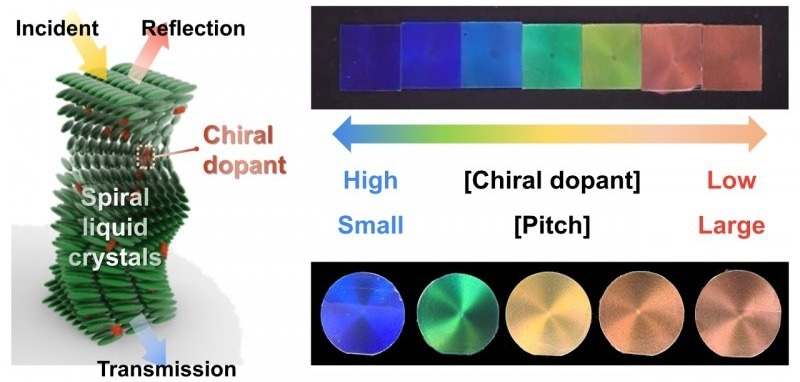Reviewed by Lexie CornerAug 12 2024
Dr. Jin Gu, Kang, and his team at the Nanophotonics Research Center of the Korea Institute of Science and Technology (KIST) have developed a vibrant radiation-cooling liquid crystal material that cools without requiring external power while simultaneously emitting color. The research findings were published in the Chemical Engineering Journal.

(Left) Schematic depicting the molecular arrangement and light-matter interaction in the cooling material: a photonic crystal based on spiral liquid crystals. (Right) Actual photographs of the materials in a variety of colors. Full-domain color is achieved by controlling the amount of additives (i.e., chiral dopants). Image Credit: Korea Institute of Science and Technology
Radiative cooling, a method that releases heat as infrared radiation through the atmospheric window, lowers temperatures without requiring external power. This environmentally friendly technology is gaining popularity as a complement to energy-intensive air conditioners. Traditionally, white-colored radiant cooling materials are used during the day to minimize sunlight absorption, offering excellent cooling performance. However, their aesthetic limitations make them unsuitable for vehicles or buildings that require a more visually appealing appearance.
As a result, there has been a growing interest in developing colored radiative cooling materials that combine aesthetics with cooling. Previous attempts to create these materials either resulted in low-temperature drops or limited color options. However, photonic crystals, which reflect light, have shown promise in achieving both distinct colors and effective cooling performance.
To address these challenges, the research team developed bent spiral liquid crystal photonic crystals. They used a commercial liquid crystal (LC242) that forms colored photonic crystals when aligned into a spiral structure with the help of an inducer. Unlike conventional photonic crystals, which change color depending on the viewing angle, the researchers created stable, angle-independent colors by bending the crystals using a spin-coating process.
The team combined this colored radiation-cooling liquid crystal material with an upper transparent film and a lower metallic thin film, achieving a temperature of approximately 30.8 °C lower than the same-colored commercial paint and about 3.1 °C lower than ambient air at midday. This material has potential applications in cooling outdoor recreational items and military tents without power and reducing the need for air conditioning in the exteriors of buildings and vehicles where aesthetics are important.
The colored radiation-cooling liquid crystal material developed in this study can be quickly fabricated through a low-cost, simple spin coating process. If the large-scale commercialization of this technology is successful, it will be used for cooling a wide range of fields such as electronics and mobility in the future.
Dr. Jin Gu Kang, Professor, Korea Institute of Science and Technology
The research was funded by the Ministry of Science and ICT (under Minister Lee Jong-ho) through the KIST Institutional Program, and by the Ministry of Trade, Industry and Energy (under Minister Ahn Duk-geun) (20213091010020).
Journal Reference:
Bae, S., et al. (2024). Efficient full-color daytime radiative cooling with diffuse-reflection-dominant cholesteric liquid crystals. Chemical Engineering Journal. doi.org/10.1016/j.cej.2024.149245.